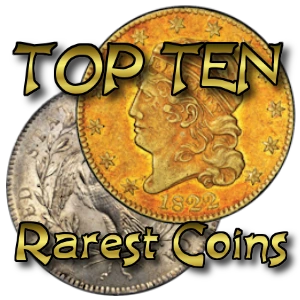1. 1933 Double Eagle

The 1933 Double Eagle is one of the most intriguing coins ever minted, not only because of its breathtaking value but also due to its unique history. This gold coin was the last of its kind to be produced by the U.S. Mint, intended as a regular circulation piece. However, due to changes in currency laws during the Great Depression, most of these coins were melted down, with only a handful surviving.
Out of potentially 445,500 originally minted, just 13 are known to exist currently. What makes the 1933 Double Eagle particularly significant is that it is the only one legally available to collectors. This exclusivity was cemented when it sold at a Sotheby's auction in 2021 for a record-breaking $18.87 million, making it the most expensive coin in the world. The coin's near-pristine condition and the extraordinary story behind its scarcity contribute to its high value.
Owning a 1933 Double Eagle goes beyond possessing a valuable item; it's about holding a piece of history. This coin represents a tumultuous period in American monetary policy and an exceptional chapter in numismatic lore. As such, it continues to captivate collectors and enthusiasts who appreciate the intersection of art, history, and investment.
2. 1794 Flowing Hair Silver Dollar
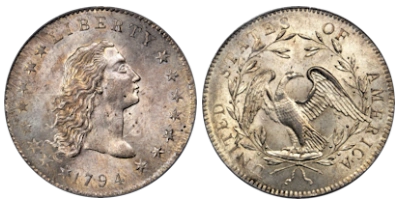
The 1794 Flowing Hair Silver Dollar is a remarkable piece of early American art and a symbol of the nation's monetary beginnings. Believed to be among the first silver dollars produced by the newly established U.S. Mint, this coin's allure extends beyond its intricate design to incorporate a notable chapter in the country's history of commerce and trade.
The coin features a portrait of Lady Liberty with flowing hair, embodying the young nation's ideals of freedom and independence. The reverse portrays an eagle, the emblem of the United States, adding deeper patriotic symbolism. The edge is inscribed with the words "Hundred Cents One Dollar or Unit," a straightforward declaration of its worth during a time when such clarity was crucial for fostering public acceptance of a centralized federal economy.
Due to its potentially inaugural status in the U.S. Mint's production line, experts speculate that only 1,758 were ever minted, with fewer than 150 believed to still exist. This extreme scarcity, coupled with its historical significance and artistic beauty, justifies why a specimen commanded an astonishing $10 million at auction in 2013, placing it among the top echelons of numismatic rarities.
Acquiring a 1794 Flowing Hair Silver Dollar is an opportunity to own a founding piece of United States history. To hold this coin is to hold a story—a narrative of a burgeoning republic finding its identity. The combination of rich history and remarkable scarcity ensures that the Flowing Hair Silver Dollar remains a celebrated highlight in the world of rare coins.
3. 1787 Brasher Doubloon
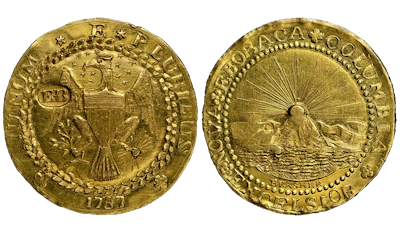
The 1787 Brasher Doubloon is a masterpiece of numismatic art crafted by Ephraim Brasher, a renowned goldsmith and silversmith. Brasher, a neighbor to Alexander Hamilton, struck these exceptional coins during a time when the young United States was still establishing its own currency system.
The coin's allure arises from Brasher's bold initiative in minting high-quality gold currency independently, despite New York State's initial rejection of his petition. The Doubloon contains nearly an ounce of solid gold, stamped with Brasher's iconic 'EB' hallmark on the eagle's breast, emphasizing its authenticity and quality. The coin captures the fledgling spirit of the United States through its neoclassical design, with one side displaying an eagle and the other showing the mythical sun rising behind Mount Ebal, a symbol of new beginnings.
Possessing a 1787 Brasher Doubloon is akin to owning a pivotal piece of American history. With only a few specimens known to exist, its rarity is unquestionable. In January 2021, an MS-65 graded example was auctioned off for $9.36 million, making it one of the most valuable coins ever sold.
The Brasher Doubloon's beauty, historical significance, and scarcity elevate it to legendary status in the numismatic world. It embodies the ambition and skillful artistry present at the nation's dawn, representing a tribute to a pioneering craftsman who minted a physical token of America's emergence as a national entity.
4. 1804 Silver Dollar Class I
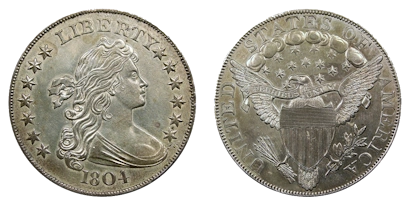
The 1804 Silver Dollar, known as the "King of Coins," is a revered numismatic treasure that blends mystery and historical prestige. Despite its 1804 date, this coin was actually struck around 1834 as part of special presentation sets created for diplomatic gifts during President Andrew Jackson's administration. These coins served as America's elegant emissaries to foreign dignitaries, from the Sultan of Muscat to the King of Siam, fostering international bonds.
The 1804 Silver Dollar's scarcity and elusiveness elevate it to the pantheon of numismatic legend. Classified into three distinct classes, with Class I exemplifying the pinnacle of allure, fewer than twenty specimens of all classes combined are estimated to survive today. The Class I series represents the finest of this coin's versions, characterized by their immaculate strike and supreme pedigree.
Owning an 1804 Silver Dollar is an investment in a revered artifact that tells tales of yesteryear's diplomacy and intrigue. Each transaction involving one of these rarities is a headline-making event in the collector world. A Class I specimen once sold for $4.1 million, reinforcing its extraordinary monetary worth and historical significance.
The 1804 Silver Dollar Class I remains a cornerstone for serious numismatists, beautifully merging the worlds of historical artifact and collector's prize. Its legacy continues to enthrall collectors and historians alike, serving as a testament to the intricate and enchanting world of coin collecting. For those at the pinnacle of their hobby or newly minted enthusiasts, the 1804 Silver Dollar represents an asset and an echo of American and global history caught within a small circle of silver.
5. 1913 Liberty Head Nickel
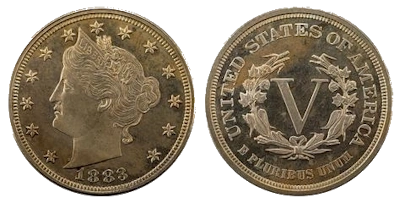
The 1913 Liberty Head Nickel, often referred to as the "phantom of the numismatic world," is one of the most fabled and curious chapters in U.S. coin collecting history. Manufactured under mysterious circumstances, this coin was never authorized by the United States Mint, yet somehow emerged amidst contention and intrigue.
The coin features the iconic left-profile of Liberty, donning a coronet and flanked by stars, with the reverse side displaying a stately 'V' crowned by the word 'Cents', encircled by a wreath. Only five specimens of the Liberty Head Nickel are known to exist—coins struck covertly when the U.S. Mint had already switched dies to commence Buffalo Nickel production. Adding to their lore is the absence of an official minting record.
Liberty Head Nickels have fetched multimillion-dollar price tags on the rare occasions they have appeared at auctions, with one exceptional sample garnering $4.2 million during a public sale. The coin's value, however, goes beyond mere economics. Each piece stands as a quiet dissenter against bureaucratic oversight, marked by the enigmatic figure of numismatist Samuel Brown, rumored to have orchestrated their unauthorized strike in 1913.
Possessing a 1913 Liberty Head Nickel is to be a custodian of a rich, albeit mysterious, slice of numismatic history. The tales surrounding this small nickel piece enhance its desirability among collectors and cement its reputation as a jewel of the rare coin realm.
For those who cherish the entwining of history with mystery, the Liberty Head Nickel remains one of the most arrestingly curious coins touched by both rumor and tangible collector zeal. Its enduring allure reminds us that sometimes, it is the stories we can't fully unfold that weave the richest tapestries in the immense anthology of coin collecting.
6. 1343 Edward III Florin
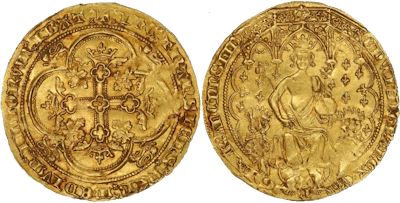
The 1343 Edward III Florin, also known as the Double Leopard. This medieval English coin is extremely rare and dates back to the 14th century.represents a fascinating period in English history. With an estimated value of about $6.8 million, it is easy to see why this coin is so highly prized by collectors.
Issued during the reign of King Edward III of England, the Double Leopard features a detailed design that reflects the era in which it was minted. The coin prominently features the king seated on a gothic throne, flanked on either side by leopards. Its denominational value was six shillings, marking it as a significant piece of currency meant to be used throughout commerce in Europe.
Only three specimens of these stunning coins are known to have survived, adding to their allure and value. The discovery of one coin in 2006 sparked global interest and opened a new chapter in the study of ancient numismatics. The Double Leopard's exceedingly limited number makes each appearance on the auction block or in scholarly articles a notable event.
To hold or even consider the 1343 Edward III Florin is to connect oneself to a rich narrative of Middle Ages economics, regal pageantry, and the enduring desire for beauty. It captures the imaginations of collectors, striking a chord with enthusiasts whose passions lie in unearthing treasures that whisper from their regal pasts. Each aspect of the Double Leopard, from its historic production to its current celebrated rarity and high valuation, ignites excitement amongst numismatists and highlights our fascination with history, relics, and collecting.
7. 1943 Bronze Lincoln Penny
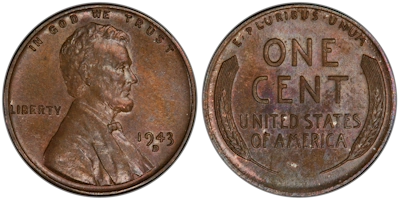
Amidst the turmoil of World War II, as resources were diverted to support the war effort, an unlikely numismatic hero emerged—the 1943 Bronze Lincoln Penny. In a remarkable twist of fate, a few bronze planchets accidentally found their way into the presses at a time when pennies were being minted in steel to conserve copper for wartime necessities.
This minting error turned an otherwise common year into a historically significant rarity. On ordinary days, the U.S. Mint's plan was to produce pennies from zinc-coated steel. However, a few leftover bronze blanks from the previous year's production were inadvertently struck with the 1943 date stamp.
The result is a rarity that few coins can match: a bronze composition amidst a sea of steel counterparts. Specimens of these bronze pennies in uncirculated condition can command valuations of approximately $1.7 million, transforming an ordinary cent into a potential treasure.
For collectors who appreciate history and rarity, securing one of these coins is akin to owning a piece of American wartime history. Each 1943 Bronze Lincoln Penny encapsulates a story—a glimpse into the frenzied operations of an overtasked mint during wartime.
Given their scarcity, any appearance of a 1943 Bronze Lincoln Penny generates excitement in auctions and stirs the passion of numismatic collectors. These coins poetically connect larger historical events with the intimate world of coin collecting.
Combining history, rarity, and a touch of mystery, these bronze outliers offer collectors a serendipitous moment in minting turned legendary. They reward the diligent few who can claim ownership—a reflection of a different age, marked by challenges but celebrated in numismatic brilliance.
8. 1822 Capped Bust Half Eagle
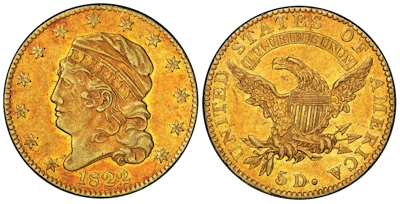
The 1822 Half Eagle was minted by the United States Mint, with a reported mintage of 17,796 pieces. However, only three examples of this coin are known to exist today, making it one of the rarest regular-issue U.S. coins.
Most of the original coins were either spent as currency, lost over time, or melted down for their gold content. One example resides in the Smithsonian Institution in Washington, D.C. This coin is part of the National Numismatic Collection and was reportedly from a collection assembled by Adam Eckfeldt.
Another specimen circulated among notable collectors during the 19th century. It passed through the hands of Joseph J. Mickley (a pioneer in American numismatics), William Sumner Appleton, and W.E. Woodward. Virgil Brand acquired it in 1899, and later, Louis Eliasberg purchased it in 1945 for $14,000.
The third and most valuable specimen, graded as **AU50** by PCGS, was owned by D. Brent Pogue. It was previously part of the collections of Virgil Brand and Louis Eliasberg. Pogue acquired it in 1982 for an impressive $687,500, which was one of the highest prices ever paid for a single coin at the time.
In March 2021, this same 1822 Capped Bust Half Eagle set a new record when it sold at a Stack’s Bowers Galleries auction in Las Vegas for an astounding $8.4 million. Not only did it become the most valuable gold coin produced by the United States Mint, but it also ranks among the top three most valuable coins ever sold at public auction
- The 1822 Half Eagle is a true trophy coin in the numismatic world. Its allure extends beyond rarity and value. It represents a piece of American history, a tangible link to the past, and a testament to the craftsmanship of early U.S. Mint engravers. The story of its survival, changing ownership, and the passion of collectors who safeguarded it over the years adds to its mystique.
9. 2007 $1 Million Canadian Gold Maple Leaf
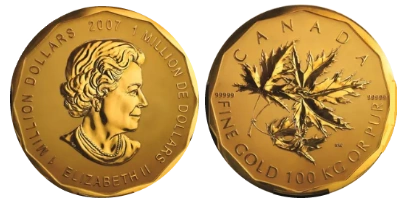
The 2007 $1 Million Canadian Gold Maple Leaf is a remarkable coin that stands out for its impressive monetary value and its status as a symbol of numismatic artistry. Produced by the renowned Royal Canadian Mint, this colossal coin is more than just a piece of currency; it is a testament to minting excellence and a fusion of intricate design and sheer value.
Weighing an astonishing 100 kilograms, the Maple Leaf is not only physically substantial but also carries the prestige of being among the most sought-after collectibles. Its creation serves as a tribute to the exceptional purity and quality of the Royal Canadian Mint's gold and as a symbol of Canada's abundant resources and skilled craftsmanship.
The coin's grandeur captures the imagination, bridging the allure of precious treasures with the sophistication of elite auction houses. Minted with an impressive purity of 99.999% gold, the $1 Million Maple Leaf features a classic design—Queen Elizabeth II's elegant profile on one side and three iconic maple leaves on the other, firmly establishing its Canadian heritage.
Initially valued at its face value of $1 million, the coin's worth has soared to an astonishing market valuation of over $4.1 million. Its immense value lies not only in its gold content and rarity but also in its significance as a symbol of national pride in craftsmanship, making it highly sought after by collectors who appreciate tangible representations of artistic legacy.
Released in a world where precious coins are typically more modest in size, the 2007 Gold Maple Leaf showcases the Royal Canadian Mint's ability to combine grand artistry with impressive metallurgy. Owning this coin positions a collector as a custodian of both a high-value item and a celebrated work of art—a masterpiece in the numismatic world.
Investing in such a coin aligns with the appreciation of a piece of history rendered in refined and reflective gold—a symbol of connoisseurship in the realm where wealth intersects with artistic achievement. In the world of collecting, where coins carry the echoes of the past and the promise of the future, the Canadian Maple Leaf tells a compelling story—one measured not just in grams but in its enduring legacy of minting excellence.
The 2007 $1 Million Canadian Gold Maple Leaf is more than a financial asset; it is an icon that resonates with the passion of collectors, interwoven with threads of opulence, history, artistry, and the enduring spirit of numismatic mastery.
10. 1795 $10 Nine Leaves Eagle

The 1795 $10 Eagle with its distinguished "9 Leaves" on the reverse is a prime example of early minting precision and historical significance. This coin, from the early days of the United States Mint, holds a special place due to its rarity and numismatic value.
Struck during America's early years, this coin symbolizes confidence in the young nation's governance and reflects a remarkable tale of cultural innovation paired with an ambition for monetary self-sufficiency. The design features Liberty with flowing hair, an allegory of freedom. The 9 Leaves variant, a subtle variation from the more common 13 Leaves versions, increases its rarity and generates even greater interest among collectors.
Known as the "King of the Small Eagle type," this coin is the rarest among its cohort. It showcases technical coinage art innovations of its period, such as V-shaped necklined busts and headdresses. These design changes prompted a series of adjustments in subsequent designs.
The coin's financial value, reaching $3.36 million at auction in January 2022, underscores its importance. Collectors appreciate its age, scarcity, and the stories behind every scratch and bit of luster preserved through over two centuries. Each cherished handling is like turning back the pages of a delicate manuscript narrating the formative years of American numismatic history.
Acquiring an item like the 1795 $10 Nine Leaves Eagle is a milestone for any collection. It offers an intimate connection with history and a deeper understanding of the early years of U.S. minting. For those fortunate enough to own such a piece, each coin unfolds as a timeless story held in the golden palms of perpetuity.

